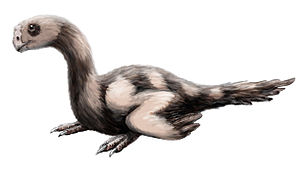Microvenator
| Microvenator | ||||||||||||
|---|---|---|---|---|---|---|---|---|---|---|---|---|

Live reconstruction |
||||||||||||
| Temporal occurrence | ||||||||||||
| Lower Cretaceous (Middle Albium ) | ||||||||||||
| 110.2 to 107.5 million years | ||||||||||||
| Locations | ||||||||||||
| Systematics | ||||||||||||
|
||||||||||||
| Scientific name | ||||||||||||
| Microvenator | ||||||||||||
| Ostrom , 1970 | ||||||||||||
| Art | ||||||||||||
|
||||||||||||
Microvenator is a genus of small theropod dinosaurs (Theropoda) from the late Lower Cretaceous (middle Albium ) of North America . The only species is the type species Microvenator celer .
It was a small, two-legged , possibly feathered, lightly built coelurosaur . The relationships of this genus are controversial; Mackovicky and Sues (1998) come to the conclusion that it is either a primitive Oviraptorosaur or a sister taxon of this group.
Find and naming
Microvenator was scientifically described by John Ostrom in 1970 using a partial skeleton ( holotype AMNH 3041) from the Cloverly layers in the south of the US state of Montana . The find is a fragmentary partial skeleton with some very fragmentary skull bones, which was discovered by Barnum Brown in 1933 . Brown thought that some of the teeth found belong to the skeleton as well, but are now ascribed to Deinonychus . Due to the size of these teeth, he concluded that the animal had a small body with an unusually large head, and unofficially named it "Megadontosaurus" ("big-tooth lizard").
Only Ostrom (1970) gave the find an official name and recognized when describing it that the teeth do not belong to the skeleton. Instead, he attributed a single tooth from the collection of the Yale Peabody Museum (YPM 5366) to the new species . In 1998, an extensive description of the find by Mackovicky and Sues followed, which also shows illustrations of the find made by Brown, which Brown had never published. These researchers were unable to confirm that the single tooth attributed by Ostrom was Microvenator .
The name Microvenator is derived from the ancient Greek mikros - "small" and the Latin venator - "hunter" and is intended to refer to a small, light-weight coelurid after Eastern Stream.
features
Microvenator was a turkey-sized, 1.5 meter long theropod. Unique features ( autapomorphies ) on the skeleton include the vertebral centers of the dorsal and caudal vertebrae, which are wider than they are high. There is also a large depression on the pubis ( pubic bone ), while the trochanter of the femur ( thigh bone ) shows an additional ridge. The specimen found was probably a young animal.
literature
- John H. Ostrom : Stratigraphy and paleontology of the cloverly formation (Lower Cretaceous) of the Bighorn Basin Area, Wyoming and Montana (= Bulletin of the Peabody Museum of Natural History. Vol. 35, ISSN 0079-032X ). Yale University - Peabody Museum of Natural History, New Haven CT 1970.
- Peter J. Makovicky , Hans-Dieter Sues : Anatomy and phylogenetic relationships of the theropod dinosaur Microvenator celer from the Lower Cretaceous of Montana (= American Museum Novitates. No. 3240, ISSN 0003-0082 ). American Museum of Natural History, New York 1998, digitized version (PDF; 3.93 MB)
Individual evidence
- ^ Gregory S. Paul : The Princeton Field Guide To Dinosaurs. Princeton University Press, Princeton NJ et al. 2010, ISBN 978-0-691-13720-9 , p. 150, online .
- ↑ Ben Creisler: Dinosauria Translation and Pronunciation Guide M. Archived from the original on November 11, 2011 ; Retrieved July 30, 2014 .
